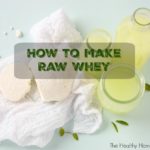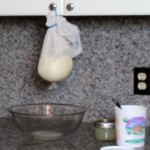How to make raw, enzyme and probiotic-rich liquid whey to use as a starter culture for all your home fermentation needs.

Do you know how to make whey from yogurt, kefir or raw milk?
A by-product of this simple technique is healthy homemade cream cheese that is loaded with enzymes and probiotics.
The recipe below describes how with visual instructions via video demonstration!
Making homemade baby formula? I recommend using this “quick whey” no straining method as the fastest and easiest approach.
How to Make Whey the REAL Way
Making real, liquid, nutrient rich, unadulterated whey in your own kitchen is a MUST step for any traditional cook to learn.
Without whey in its whole, liquid form, many other traditional recipes cannot even be attempted. You cannot buy whey from the store except in a denatured, unhealthy, powdered whey form. It is worth your time to learn what I show you in the video below.
Other video lessons on this blog show you how to use this whole food form of whey to make many delicious, healthful recipes for your family. Whey as made in the video demo below will keep up to 6 months in the refrigerator in a sealed mason jar.
If you absolutely have no access to farm fresh milk to make whole, unadulterated, enzyme rich whey, then you can use plain, organic yogurt brand from the store instead. Here are tips on how to spot the best yogurt brands.
The process is basically exactly the same thing as shown in the video.
You won’t get nearly as much whey using yogurt as clabbered, farm fresh milk, but at least you can get enough to get you started.
Wonderful Whey and REAL Cream Cheese
The raw, enzyme-rich cream cheese I make in the recipe video below is fantastic on a sprouted or sourdough bagel for breakfast. Don’t buy the Ezekiel sprouted muffins as they contain soy. This low-carb bagel recipe is another great one to try.
If you prefer to buy, these sourdough bagels are available for shipping freshly made to your door.
To make, just take your cream cheese left over from making liquid whey and add a few strawberries and a dash of dark maple syrup to taste. Mix together by pulsing a few times in your food processor. This wonderful, fresh, REAL strawberry cream cheese will last one to two weeks in the refrigerator. Another wonderful use for this healthy raw cheese is to make an easy no bake cheesecake.
No access to raw milk where you live? No problem. Check out this recipe plus video on how to separate whey from yogurt purchased from the store.
Cloudy Whey vs Clear Whey
No matter whether your whey turns out cloudy or clear, it is safe and fine to use in all your favorite recipes. This article explains why sometimes whey is cloudy compared to its usual golden color.

Raw Whey Recipe
How to separate raw, liquid whey from clabbered milk. The process also creates probiotic rich cream cheese.
Ingredients
- 1 quart raw milk preferably grassfed
- 1 large glass bowl
- 1 large rubber band
- 1 white dishtowel
Instructions
-
Allow the raw milk to sit on the counter for 1-3 days at room temperature.
-
When the milk separates into curds and whey (transforms into clabbered milk) you are ready to proceed. Note that the fresher the raw milk and the colder the temperature of your house, the longer it will take the raw milk to clabber.
-
Line a clean, large glass bowl with a clean, white dishtowel that isn’t too thick. Cheesecloth will also work, but the holes in the mesh must be very small, else the milk curds will pass through.
-
Gently pour the clabbered milk into the middle of the dish towel. Gather up the ends and fasten with a rubber band. Attach to a knob on an upper cabinet in your kitchen as shown in the picture.

-
Let the raw whey drip into the bowl underneath. This process will continue for an hour or two.
-
After the dripping stops, gently take down the hanging bag and place it into a clean bowl. Scrape out the raw cream cheese that is inside the bag, put in a container with a lid and refrigerate.
-
Pour the liquid whey from the dripping bowl into a glass mason jar, afix the lid and refrigerate.
-
Refrigerated, raw cream cheese will be good to eat for about a week. Raw whey will last several months refrigerated.
Recipe Video
How to Use Whey in Recipes
How to Make Ricotta Three Ways (plus Video How-to)
Perfect Probiotic Cottage Cheese
Cheese Making: Common Problems and Solutions








I know this is a really old post but I just tried this with very fresh raw milk. It is fairly warm in my kitchen. I didn’t check it at all for about 2.5 days. The entire jar looks like the consistency of yogurt. It smells like yogurt. Will it separate? Should I wait longer or did I leave it out too long for whey? Thanks!
Is it normal/acceptable for the cream to bubble a bit when it is separated?
Is it ok for it not to be sealed air tight when separating? Mine has been iut kn the counter about 48 hrs but its been a bit cooler in our house. It has a sour smell but I’m not familiar to know whether its a good smell or no?
I have started with fresh raw milk, but its from the health food section of our grocery store. I have now heard that milk labeled raw is often still heated…
Maybe mine isn’t ok for this?
Hi Sarah:
I followed your instructions to the “T” but I find that the results varies all the time. I have been making raw whey 2x a week from an A2 raw goat milk for my daughter’s baby formula. However, the one I made recently took longer than usual (5 days) and I have noticed yellow mold (?) floating on top of the clabbered milk. I wasn’t sure if it’s dangerous to consume or if I have let the milk sit far too long. Please enlightened me on this I have made another fresh batch and the method and the result was the same 🙁
I didn’t want to keep throwing a perfectly good whey out of my own ignorance *.*
Yes, the results do vary from batch to batch. Sometimes the whey is cloudy, sometimes clear. This is one of the wonders of home fermentation! https://www.thehealthyhomeeconomist.com/whey-benefits-cloudy-or-clear/
The yellow is probably kahm yeast, not mold. https://www.thehealthyhomeeconomist.com/mold-fermented-foods-what-to-do/
This may be something that has been answered already, I’ve been scrolling through years of comments. If I don’t want the cream cheese and only want whey, can I clabber whole raw milk that has been skimmed? As in, I take the cream off the top to make butter, and clabber the remaining “skimmed” milk to get whey?
If I have soured milk that has been in the freezer, can I use that to make the clabbered milk and whey? I didn’t want to throw it out (it’s grass-fed), so I froze it. Thanks!
Yes, you can make clabbered milk with soured milk.
it looks so delicious and healthy. i’m giving this a try
If I have a grass fed cow and I milk the cow and the milk is warm fresh milk. If I put rennet in it to separate it, that whey is the one that is no good to drink?
I had a question. I’ve been wanting to try making whey for a long time but always hesitate and my milk turns so old that I hesitate to try it. I left some out last Thursday and barely strained it Monday night. Is that too old? How do you know when it’s been to long to have healthy whey? Sorry, hope my questions make sense.
Liquid whey is fine as long as there isn’t any mold on it. Leaving it out more than a couple of days will make it stronger tasting, but it won’t be bad. I like to strain mine as soon as it separates so that the whey is as mild tasting as possible.
I’m thinking of making yoghurt to get whey. The organic yoghurt I buy is quite firm and I think homemade yoghurt will be less firm and produce more whey. I have no access to raw milk, does regular organic milk and organic yoghurt as starter produce the whey I need for your fermenting recipes?
Yes, you can use organic milk as long as it is not ultrapasteurized. Look for regular pasteurized milk or low temp pasteurized/nonhomogenized (cream on top) milk. That will ferment fine into yogurt from which you can make whey from.
If we don’t have access to raw milk, can we replace it by yogurt? What quantity?
Yes, yogurt is fine. Check out this recipe and video. https://www.thehealthyhomeeconomist.com/separating-whey-plain-store-yogurt/